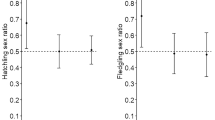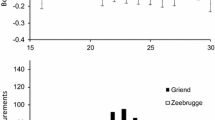Abstract
Male smallmouth bass show size-based variation in both probability and timing of reproduction. The objective of this research was to determine seasonal and size-based patterns of depletion of energy reserves and determine if parental defense is related to males' energy reserves. We sampled male smallmouth bass in the spring, during the parental care period and in the fall to measure energy reserves (lipid stores in muscle and viscera tissue) over a two year period. Energy stores, which were not built up before nesting, declined to a minimum level by the end of the parental care period. Small males had consistently lower energy reserves than larger males and did not utilize these reserves at the same rate during the parental care period. All parental males complimented endogenous energy reserves by feeding during parental care, however, small males appear to rely proportionately more on exogenous energy intake than do larger males. Parental defense by all sizes of males declined over the parental care period, the decline being the most obvious by small males. Small males' lower energy budget may make them less effective parents and decrease their probability of survival over the following winter relative to larger males.
Similar content being viewed by others
References cited
Adams, S.M., R.B. McLean & J.A. Parrotta. 1982. Energy partitioning in largemouth bass under conditions of seasonally fluctuating prey availability. Trans. Amer. Fish. Soc. 111: 549–558.
Bligh, E.G. & W.J. Dyer. 1959. A rapid method of total lipid extraction and purification. Can. J. Biochem. Physiol. 37: 911–917.
Blumer, L.S. 1979. Male parental care in the bony fishes. Quart. Rev. Biol. 54: 149–161.
Brett, J.R. 1965. The relation of size to rate of oxygen consumption and sustained swimming speed of sockeye salmon (Oncorhynchus nerka). J. Fish. Res. Board Can. 22: 1491–1501.
Brett, J.R. & T.D.D. Groves. 1979. Physiological energetics. pp. 279–352. In: W.S. Hoar, D.J. Randall & J.R. Brett (ed.) Fish Physiology, Vol. 8, Academic Press, New York.
Chellappa, S. & F.A. Huntingford. 1989. Depletion of energy reserves during reproductive aggression in male three-spined stickleback, Gasterosteus aculeatus L. J. Fish Biol. 35: 315–316.
Chellappa, S., F.A. Huntingford, R.H.C. Strang & R.Y. Thomson. 1989. Annual variation in the energy reserves in male three-spined stickleback, Gasterosteus aculeatus L. (Pisces, Gasterosteidae). J. Fish Biol. 35: 275–286.
Clutton-Brock, T.H. & C. Godfray. 1991. Parental investment. pp. 234–262. In: J.R. Krebs & N.B. Davies (ed.) Behavioural Ecology: An Evolutionary Approach. 3rd ed., Blackwell Scientific Publications, London.
Coleman, R.M., M.R. Gross & R.C. Sargent. 1985. Parental investment decision rules: a test in the bluegill sunfish. Behav. Ecol. Sociobiol. 18: 59–66.
Coleman, R.M. & R.U. Fischer. 1991. Brood size, male fanning effort and the energetics of a non-shareable parental investment in bluegill sunfish, Lepomis macrochirus (Teleostei: Centrarchidae). Ethology 87: 177–188.
Dufresne, F., G.J. FitzGerald & S. Lachance. 1990. Age and size-related differences in reproductive success and reproductive costs in threespine sticklebacks (Gasterosteus aculeatus). Behav. Ecol. 1: 140–147.
FitzGerald, G.J., H. Guderley & P. Picard. 1989. Hidden reproductive costs in the threespine stickleback (Gasterosteus aculeatus). Exper. Biol. 48: 295–300.
Gross, M.R. & R.C. Sargent. 1985. The evolution of male and female parental care in fishes. Amer. Zool. 25: 807–822.
Helfman, G.S. 1983. Resin-coated fishes: a simple model technique for in situ studies of fish behaviour. Copeia 1983: 547–549.
Herbes, S.E. & C.P. Allen. 1983. Lipid quantification of freshwater invertebrates: method modification for microquantitation. Can. J. Fish. Aquat. Sci. 40: 1315–1317.
Hinch, S.G. & N.C. Collins. 1991. Importance of diurnal and nocturnal nest defense in the energy budget of male smallmouth bass: insights from direct video observations. Trans. Amer. Fish. Soc. 120: 657–663.
Hirshfield, M.F. 1980. An experimental analysis of reproductive effort and cost in the Japanese medaka, Oryzias latipes. Ecology 61: 282–292.
Jennings, M.J. & D.P. Philipp. 1992. Reproductive investment and somatic growth rates in longear sunfish. Env. Biol. Fish. 35: 257–271.
Keast, A. 1968. Feeding of some Great Lakes fishes at low temperatures. J. Fish. Res. Board Can. 25: 1199–1218.
Kolok, A.S. 1991. Temperature compensation in two centrachid fishes: do winter-quiescent fish undergo cellular temperature compensation? Trans. Amer. Fish. Soc. 120: 52–57.
Mackereth, R.W. 1995. Size-based variation in the allocation of energy to parental care by male smallmouth bass (Micropterus dolomieu). Ph.D. Dissertation, University of Guelph, Guelph. 119 pp.
Marconato, A., A. Bisazza & M. Fabris. 1993. The cost of parental care and egg cannibalism in the river bullhead, Cottus gobio L. (Pisces, Cottidae). Behav. Ecol. Sociobiol. 32: 229–237.
Martin, N.V. & F.E.J. Fry. 1972. Lake Opeongo: effects of exploitation and introductions on the salmonid community. J. Fish. Res. Board Can. 29: 795–805.
Medford, B.A. & W.C. McKay. 1978. Protein and lipid contents of gonads, liver, and muscle of northern pike (Esox lucius) in relation to gonad growth. J. Fish. Res. Board Can. 35: 213–219.
Nelson, J.A. & J.J. Magnuson. 1992. Metabolic stores of yellow perch (Perca flavescens): comparison of populations from an acidic, dystrophic lake and circumneutral, mesotrophic lakes. Can. J. Fish. Aquat. Sci. 49: 2474–2482.
Pressley, P.H. 1981. Parental effort and the evolution of nest-guarding tactics in the threespine stickleback, Gasterosteus aculeatus L. Evolution 35: 282–295.
Ridgway, M.S. 1988. Developmental stage of offspring and brood defense in smallmouth bass (Micropterus dolomieui). Can. J. Zool. 66: 1722–1728.
Ridgway, M.S. 1989. The parental response to brood size manipulation in smallmouth bass (Micropterus dolomieui). Ethology 80: 47–54.
Ridgway, M.S. & T.G. Friesen. 1992. Annual variation in parental care in smallmouth bass, Micropterus dolomieu. Env. Biol. Fish. 35: 243–255.
Ridgway, M.S. & B.J. Shuter. 1996. Effects of displacement on the seasonal movements and home range characteristics of smallmouth bass in Lake Opeongo. North Amer. J. Fish. Manage. 16: 371–377.
Ridgway, M.S., B.J. Shuter & E.E. Post. 1991a. The relative influence of body size and territorial behaviour on nesting asynchrony in male smallmouth bass, Micropterus dolomieui (Pisces: Centrarchidae). J. Anim. Ecol. 60: 665–681.
Ridgway, M.S., J.A. MacLean & J.C. MacLeod. 1991b. Nest-site fidelity in a centrarchid fish, the smallmouth bass (Micropterus dolomieui). Can. J. Zool. 69: 3103–3105.
Robinson, W.R., R.H. Peters & J. Zimmerman. 1983. The effects of body size and temperature on metabolic rate of organisms. Can. J. Zool. 61: 281–288.
Sabat, A.M. 1994. Costs and benefits of parental effort in a brood-guarding fish (Ambloplites rupestris, Centrarchidae). Behav. Ecol. 5: 195–201.
Sargent, R.C. & M.R. Gross. 1985. Parental investment decision rules and the Concorde fallacy. Behav. Ecol. Sociobiol. 17: 43–45.
Sargent, R.C. & M.R. Gross. 1986. Williams' principle: an explanation of parental care in teleost fishes. pp. 275–293. In: T.J. Pitcher (ed.) The Behaviour of Teleost Fishes, Croom Helm, London.
Schmidt-Nielsen, K. 1972. Locomotion: energy cost of swimming, flying, and running. Science 117: 222–228.
Schultz, E.T. 1991. The effect of energy reserves on breeding schedule: is there a saturation point? Func. Ecol. 5: 819–824.
Schultz, E.T., L.M. Clifton & R.R. Warner. 1991. Energetic constraints and size-based tactics: the adaptive significance of breeding-schedule variation in a marine fish (Embiotocidae: Micrometrus minimus). Amer. Nat. 138: 1408–1430.
Scott, R.J., M.S. Ridgway & D.L.G. Noakes. 1997. The nest range of male smallmouth bass: parental care after swim-up. Can. J. Zool. 75: 2058–2062.
Scott, W.B. & E.J. Crossman. 1973. Freshwater fishes of Canada. Bull. Fish. Res. Board Can. 184. 966 pp.
Shuter, B.J., J.A. MacLean, F.E.J. Fry & H.A. Regier. 1980. Stochastic simulation of temperature effects on first-year survival of smallmouth bass. Trans. Amer. Fish. Soc. 109: 1–34.
Shuter, B.J. & J.R. Post. 1990. Climate, population viability, and the zoogeography of temperate fishes. Trans. Amer. Fish. Soc. 119: 314–336.
Townshend, T.J. & R.J. Wootton. 1985. Adjusting parental investment to changing environmental conditions: the effect of food ration on parental behaviour of the convict cichlid, Cichlasoma nigrofasciatum. Anim. Behav. 33: 494–501.
Trivers, R.L. 1972. Parental investment and sexual selection. pp. 136–179. In: B. Campbell (ed.) Sexual Selection and the Descent of Man 1871–1971, Aldine Publishing Company, Chicago.
Voet, D. & J.G. Voet. 1990. Biochemistry. John Wiley and Sons, New York. 1223 pp.
Webster, D.A. 1954. Smallmouth bass, Micropterus dolomiuei, in Cayuga Lake. Part 1. Life history and environment. Memoir 327, Agriculture Experimental Station, Cornell University, Ithaca. 39 pp.
Weigmann, D.D., J.R. Baylis & M.H. Hoff. 1992. Sexual selection and fitness variation in a population of smallmouth bass, Micropterus dolomieui (Pisces: Centrarchidae). Evolution 46: 1740–1753.
Williams, G.C. 1966. Adaptation and natural selection. Princeton University Press, Princeton. 307 pp.
Wootton, R.J. 1985. Energetics of reproduction. pp. 231–254. In: P. Tyler & P. Calow (ed.) Fish Energetics, Croom Helm, London.
Zar, J.H. 1984. Biostatistical analysis, 2nd ed.. Prentice-Hall, Englewood Cliffs. 718 pp.
Author information
Authors and Affiliations
Rights and permissions
About this article
Cite this article
Mackereth, R.W., Noakes, D.L. & Ridgway, M.S. Size-Based Variation in Somatic Energy Reserves and Parental Expenditure by Male Smallmouth Bass, Micropterus dolomieu. Environmental Biology of Fishes 56, 263–275 (1999). https://doi.org/10.1023/A:1007580323816
Issue Date:
DOI: https://doi.org/10.1023/A:1007580323816




